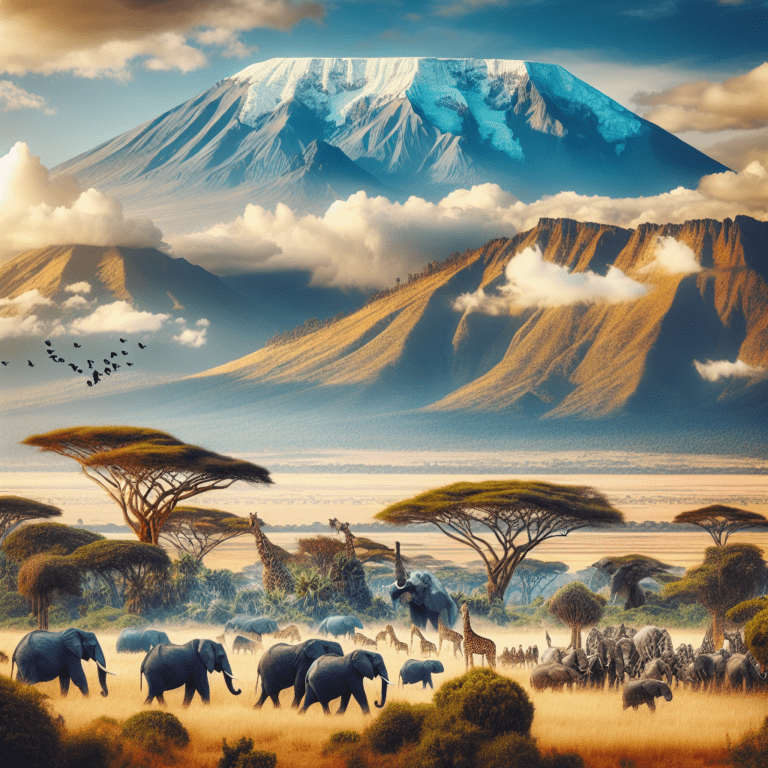What Are The Major Environmental Challenges Facing Kenya?
Kenya, a land of breathtaking landscapes and diverse wildlife, is facing its fair share of environmental challenges. From deforestation to pollution, these threats are putting the country’s natural beauty and resources at risk. With a rapidly growing population and increasing industrialization, Kenya must confront issues such as unsustainable farming practices, water scarcity, and climate change. This article will delve into the major environmental challenges currently facing Kenya, exploring the impacts they have on both the environment and its people, and discussing the potential solutions that can help preserve this magnificent nation for future generations.
Deforestation
Deforestation refers to the permanent removal of forest cover or trees from a particular area. This significant environmental issue has severe consequences for both the natural world and human society. Loss of forest cover occurs due to various reasons, including agricultural expansion, logging, and infrastructure development. Unfortunately, deforestation has a detrimental impact on biodiversity, contributing to the loss of plant and animal species. The destruction of habitats disrupts delicate ecological balances, leading to imbalances within ecosystems. Consequently, this threatens the survival of numerous species and reduces overall biodiversity.
Apart from the impact on biodiversity, deforestation also contributes to climate change. Trees play a crucial role in mitigating climate change by absorbing carbon dioxide from the atmosphere through photosynthesis. They act as natural carbon sinks, helping to regulate the Earth’s climate. When trees are cut down and forests cleared, this essential function is diminished, and the carbon dioxide levels in the atmosphere increase. Additionally, forests release stored carbon when they are burned or degraded, further exacerbating climate change. Therefore, deforestation not only reduces the Earth’s capacity to absorb greenhouse gases but also releases large amounts of carbon dioxide back into the atmosphere.
Pollution
Pollution encompasses various forms, including air pollution, water pollution, and plastic pollution. Each of these types of pollution poses significant threats to both the environment and human health.
Air pollution is a pressing environmental issue that arises from the release of harmful substances into the atmosphere. In Kenya, air pollution is primarily caused by industrial activities, vehicular emissions, and the burning of solid fuels for cooking and heating. These pollutants, such as fine particulate matter and nitrogen dioxide, contribute to respiratory diseases, cardiovascular problems, and even premature death. Moreover, air pollution also affects ecosystems, harming vegetation and impacting the delicate balance of ecological systems.
Water pollution is another critical concern in Kenya, particularly with regard to freshwater sources. Contamination of rivers, lakes, and underground water reservoirs occurs due to the discharge of industrial and domestic waste, improper sewage disposal, and agricultural runoff. This leads to the deterioration of water quality and poses risks to human health. Consuming polluted water can cause waterborne diseases such as cholera, typhoid, and hepatitis. Additionally, water pollution has devastating effects on aquatic ecosystems, threatening various species and disrupting the delicate balance of marine life.
Plastic pollution has become a widespread environmental problem in recent years. The improper disposal of plastic waste, including single-use plastic items such as bottles and bags, pollutes land, rivers, and oceans. In Kenya, plastic waste often ends up in water bodies after being discarded on the streets or improperly disposed of in open spaces. Plastic pollution not only impacts marine life and ecosystem health but also affects tourism and the economy. Efforts to reduce plastic consumption and improve waste management practices are crucial in combating this issue.
Water scarcity
Water scarcity is a critical environmental challenge in Kenya, with dwindling water resources posing significant threats to both human livelihoods and agricultural productivity. As the population continues to grow, the demand for water increases, placing strain on existing water sources. Climate change further exacerbates this issue, as it leads to reduced rainfall and more frequent droughts.
Dwindling water resources have severe consequences for both rural and urban communities. In rural areas, limited access to clean water negatively affects agriculture, as farmers struggle to irrigate their crops and support livestock. This leads to reduced crop yields and diminished food security. Moreover, the lack of clean water also poses health risks, as communities may resort to using contaminated water sources, leading to waterborne diseases.
Inequitable access to water is another pressing issue in Kenya. While some regions face water scarcity, others have abundant water resources. This unequal distribution of water further widens the gap between the haves and have-nots, perpetuating poverty and social inequality. Improving access to clean water for all communities, particularly those most vulnerable, is crucial for achieving sustainable development and addressing this challenge effectively.
Soil degradation
Soil degradation refers to the deterioration of soil quality, making it less fertile and less capable of supporting agricultural activities. This process occurs primarily due to erosion, desertification, and the loss of soil fertility.
Erosion, accelerated by human activities and climate change, is a significant cause of soil degradation in Kenya. Unsustainable farming practices, such as overgrazing, improper land management, and deforestation, lead to increased erosion rates. Topsoil, which contains vital nutrients for plant growth, is eroded away, resulting in reduced agricultural productivity. Additionally, eroded soil can contribute to water pollution, as sediment enters water bodies, affecting both aquatic ecosystems and water quality.
Desertification is another consequence of soil degradation, particularly in arid and semi-arid regions of Kenya. It occurs when fertile land turns into desert-like conditions, making it unsuitable for cultivation. Factors contributing to desertification include climate change, deforestation, over-cultivation, and improper irrigation practices. Desertification not only affects agriculture and food security but also displaces communities and leads to increased poverty and social instability.
Loss of soil fertility is a long-term consequence of unsustainable agricultural practices and nutrient depletion. Continuous crop cultivation without proper soil management practices leads to a decline in soil fertility, as nutrients are not replenished adequately. This results in reduced crop yields, decreased agricultural productivity, and increased reliance on chemical fertilizers, further exacerbating the issue. Implementing sustainable agricultural practices, such as crop rotation and organic farming, is crucial for preserving soil fertility and ensuring long-term food security.
Climate change
Climate change, driven by human activities and exacerbated by global warming, is one of the most pressing environmental challenges worldwide, including in Kenya. Rising temperatures, erratic rainfall patterns, and increased frequency of extreme weather events characterize this phenomenon.
Rising temperatures have significant implications for ecosystems, agriculture, and public health. As temperatures increase, the risk of heat-related illnesses and deaths rises. Moreover, changing climate conditions impact agricultural productivity, as certain crops become less viable in new climatic conditions. This can lead to food shortages, higher food prices, and increased vulnerability to hunger and malnutrition.
Erratic rainfall patterns have severe consequences for agricultural activities and water availability. Inconsistent rainfall distribution hampers crop growth and reduces agricultural yields, leading to decreased food production and food security. Additionally, droughts and floods, which can occur as a result of unpredictable rainfall patterns, further disrupt agricultural systems, damage infrastructure, and displace communities.
Increased frequency of extreme weather events, such as hurricanes, storms, and floods, is a direct result of climate change. These events have devastating impacts on human lives, infrastructure, and ecosystems. Flooding, for instance, leads to property destruction and the displacement of communities. Furthermore, the destruction of natural habitats due to extreme weather events poses risks to biodiversity conservation efforts.
Wildlife conservation
Wildlife conservation is a critical environmental challenge in Kenya due to factors such as poaching, habitat destruction, and illegal wildlife trade. Kenya is renowned for its rich biodiversity, and efforts to protect wildlife are essential for maintaining healthy ecosystems and preserving species for future generations.
Poaching, driven by the illegal trade of animal parts, remains a severe threat to wildlife populations in Kenya. Elephants, rhinos, and other iconic species are particularly vulnerable to poaching for their ivory and horns. The loss of these keystone species can have cascading effects on entire ecosystems, disrupting natural balance and biodiversity. Combatting poaching requires increased law enforcement efforts, community engagement, and international cooperation.
Habitat destruction is another critical issue affecting wildlife conservation in Kenya. The conversion of natural habitats into agricultural land, infrastructure development, and urban expansion reduces available space for wildlife to thrive. Destruction of ecosystems not only threatens the survival of endangered species but also impacts the overall functioning of ecosystems. Promoting sustainable land use practices, protected areas, and habitat restoration are essential for safeguarding wildlife habitats.
Illegal wildlife trade is a lucrative criminal enterprise that poses a significant threat to wildlife populations in Kenya. The trade involves the smuggling and sale of live animals, animal parts, and products derived from wildlife. This activity leads to the endangerment of various species and disrupts ecosystems. Kenya has implemented robust measures to combat illegal wildlife trade, including strengthening legislation, increasing surveillance, and raising public awareness of the importance of conservation.
Waste management
Effective waste management is crucial for maintaining a clean and healthy environment. However, limited waste disposal infrastructure, improper waste disposal practices, and the lack of awareness pose significant challenges in Kenya.
Limited waste disposal infrastructure is a pressing issue in Kenya, particularly in urban areas. Insufficient waste management facilities result in inadequate garbage collection and disposal services. This leads to the accumulation of waste in public spaces, rivers, and other natural habitats, causing environmental pollution and health hazards. Investment in waste management infrastructure and the establishment of effective waste collection systems are essential for addressing this issue.
Improper waste disposal practices, including open dumping and burning of waste, exacerbate environmental pollution. Open dumping contaminates soil and water sources, contributing to soil and water pollution. Burning waste not only releases harmful gases into the atmosphere but also poses risks to human health. Promoting proper waste segregation, recycling, and composting practices can help minimize the environmental impact of waste disposal.
Health and environmental risks are associated with poor waste management practices. Accumulated waste attracts pests and vermin, leading to the spread of diseases. Moreover, the toxic substances present in certain types of waste can contaminate soil and water, posing risks to human and ecosystem health. Improved waste management practices, including public education and awareness campaigns, can help mitigate these risks and create a cleaner, healthier environment.
Energy access
Access to reliable and affordable energy is crucial for economic development and human well-being. However, in Kenya, limited access to electricity, reliance on biomass and fossil fuels, and the importance of renewable energy pose challenges to achieving universal energy access.
Limited access to electricity is a significant issue, particularly in rural areas of Kenya. Many communities still rely on traditional and inefficient energy sources, such as kerosene lamps and candles, for lighting and cooking. This not only hampers productivity but also poses health and safety risks. Expanding the electricity grid into rural areas and promoting off-grid renewable energy solutions, such as solar panels and small-scale hydropower projects, can improve energy access for these communities.
Reliance on biomass and fossil fuels, such as firewood and charcoal, for cooking and heating is another challenge in Kenya. This reliance poses significant health risks, as the combustion of biomass and fossil fuels produces indoor air pollution, leading to respiratory diseases and premature deaths. Transitioning to cleaner and more sustainable cooking and heating methods, such as improved cookstoves and renewable energy sources, can help improve indoor air quality and reduce the pressure on forests.
The importance of renewable energy in Kenya’s energy transition cannot be overstated. Renewable energy sources, such as solar, wind, and geothermal, offer a sustainable alternative to traditional fossil fuels. Kenya has made significant strides in harnessing renewable energy, particularly through the development of large-scale wind and solar power plants. Continued investment in renewable energy infrastructure, policies, and research is crucial for diversifying the energy mix and increasing energy access in a sustainable manner.
Overpopulation
Overpopulation is a complex environmental challenge that arises from the rapid growth of human populations. In Kenya, the increasing population places pressure on resources, presents urbanization challenges, and strains infrastructure.
The growing population in Kenya leads to increased demand for resources, such as land, water, and energy. This pressure on resources can result in overexploitation, environmental degradation, and competition for limited resources. Sustainable resource management practices, population education, and family planning programs are essential for addressing this challenge and achieving a balance between population growth and resource availability.
Urbanization challenges accompany overpopulation, particularly in cities and urban areas. Rapid urbanization leads to increased demand for housing, infrastructure, and services. However, the rapid pace of urban growth often exceeds the capacity of infrastructure and services to keep up. This results in overcrowding, inadequate housing, inadequate sanitation facilities, and strain on natural resources. Urban planning, investment in infrastructure, and sustainable urban development strategies are necessary for managing the challenges posed by overpopulation and urbanization.
The strain on infrastructure is another consequence of overpopulation. As the population grows, there is a need for expanded transportation networks, water and sanitation systems, and energy infrastructure. Ensuring that infrastructure keeps pace with population growth is crucial for maintaining a high quality of life for all residents and supporting sustainable development.
Land degradation
Land degradation refers to the deterioration of the quality and productivity of land, rendering it less suitable for agriculture and other forms of land use. In Kenya, land degradation occurs mainly due to deforestation, soil erosion, and illegal land grabbing.
Deforestation, as previously discussed, contributes significantly to land degradation. The removal of trees and vegetation cover leads to soil erosion, reduced soil fertility, and the loss of habitat for many species. Implementing reforestation and afforestation programs, combined with sustainable land use practices, can help combat deforestation and restore degraded land.
Soil erosion is another critical factor in land degradation. Unsustainable farming practices, such as overgrazing, improper land management, and intensive cultivation, accelerate erosion rates. As topsoil is eroded, the fertility of the land is reduced, leading to decreased agricultural productivity. The adoption of soil conservation techniques, such as terracing, contour plowing, and agroforestry, is vital in preventing soil erosion and preserving valuable topsoil.
Illegal land grabbing poses a significant threat to Kenya’s land resources. Land grabbing involves the illegal seizure or acquisition of land, often for commercial purposes. This practice not only leads to the displacement of local communities but also results in environmental degradation. Illegal land grabbing often involves deforestation, encroachment on protected areas, and the destruction of valuable ecosystems. Effective land governance and enforcement of land rights are crucial for preserving land resources and preventing further degradation.
In conclusion, Kenya faces a range of environmental challenges that require urgent attention and action. Deforestation, pollution, water scarcity, soil degradation, climate change, wildlife conservation, waste management, energy access, overpopulation, and land degradation all pose significant threats to the environment, biodiversity, human health, and sustainable development. Addressing these challenges requires a multifaceted approach involving sustainable resource management, conservation efforts, renewable energy promotion, improved waste management, and proactive policy-making. By prioritizing environmental sustainability, Kenya can pave the way for a greener future, ensuring the well-being and prosperity of both current and future generations.







